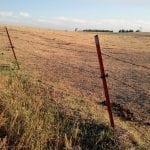 Dr. Jason Warner is the new Extension Cow-Calf Specialist and assistant professor in the Kansas State University Department of Animal Sciences and Industry. Warner’s objective is to help support the mission of the land grant system by serving people through extension and research as part of the K-State beef extension team. Continue reading “Warner Joins K-State Animal Sciences and Industry Department as Extension Cow-Calf Specialist”
Dr. Jason Warner is the new Extension Cow-Calf Specialist and assistant professor in the Kansas State University Department of Animal Sciences and Industry. Warner’s objective is to help support the mission of the land grant system by serving people through extension and research as part of the K-State beef extension team. Continue reading “Warner Joins K-State Animal Sciences and Industry Department as Extension Cow-Calf Specialist”
Category: September 2022
Supplementation Considerations during Drought
Justin Waggoner, Ph.D., Beef Systems Specialist, Garden City
 Traditionally, when cowherd supplementation is discussed we focus on meeting the protein needs of the cow, with the goal of maximizing forage intake by supplementing protein, the most limiting nutrient in dormant native forages. However, drought often limits the supply of both grazed and harvested forages in many regions. In this scenario both energy and protein are limiting cow performance and therefore, supplements should be evaluated on both their energy and protein contributions to the nutrition program. When evaluating potential feedstuffs as supplements consider both the cost per unit of energy (TDN, net energy maintenance or metabolizable energy) and crude protein basis Continue reading “Supplementation Considerations during Drought”
Traditionally, when cowherd supplementation is discussed we focus on meeting the protein needs of the cow, with the goal of maximizing forage intake by supplementing protein, the most limiting nutrient in dormant native forages. However, drought often limits the supply of both grazed and harvested forages in many regions. In this scenario both energy and protein are limiting cow performance and therefore, supplements should be evaluated on both their energy and protein contributions to the nutrition program. When evaluating potential feedstuffs as supplements consider both the cost per unit of energy (TDN, net energy maintenance or metabolizable energy) and crude protein basis Continue reading “Supplementation Considerations during Drought”
Sampling Procedures for Silage Crops
Jason Warner, extension cow-calf specialist
 With the unusually dry conditions this year, much of the corn across the state may already be harvested for silage or will be soon. Chopping sorghum/sudan crops and other summer annuals for silage will not be far off as well. As a continuation of Dr. Waggoner’s article in August Feedlot Facts, the goal with this discussion is to focus our attention of the importance of proper silage sampling. Continue reading “Sampling Procedures for Silage Crops”
With the unusually dry conditions this year, much of the corn across the state may already be harvested for silage or will be soon. Chopping sorghum/sudan crops and other summer annuals for silage will not be far off as well. As a continuation of Dr. Waggoner’s article in August Feedlot Facts, the goal with this discussion is to focus our attention of the importance of proper silage sampling. Continue reading “Sampling Procedures for Silage Crops”
Safety Net Program Payments and Drought Costs
Jennifer Ifft, Robin Reid, Cordon Rowley, Agricultural Economics
With ongoing severe drought in many parts of Kansas, cattle producers continue to face tough decisions: how to feed their cattle and whether to increase culling rates. Several safety net programs are available through Federal insurance products (Annual Forage, Pasture Rangeland and Forage–PRF, others) and the Farm Service Agency (Emergency Assistance for Livestock, Honey Bees, and Farm-raised Fish–ELAP, Livestock Forage Disaster Program–LFP, others). The purpose of these safety net programs is to make payments that would ultimately make these decisions a little less painful: money to help keep feeding your cattle or to save for eventual restocking or a combination of the two. The objective of this article is to provide an example of the magnitude of safety net payments and the financial tradeoffs that cattle producers are currently facing. Continue reading “Safety Net Program Payments and Drought Costs”
Winter Annual Forages for Cattle
Jaymelynn Farney, beef systems specialist, Parsons
If moisture becomes available here is a short discussion about fall forage options for grazing. There are two main classes of forages, cereal grains and brassicas, that have success growing in Kansas and can provide a cost-effective tool to provide gains for stockers and increase weight on thin cows. Continue reading “Winter Annual Forages for Cattle”
Dryland Corn Considerations for 2022
 Dryland corn in many parts of western KS is struggling. Some areas have been fortunate to receive rain showers that may result in more growth, but in other cases the plants are already dead and on the ground. Dry conditions are reducing production in both native pastures and forages typically used for winter feeding, so making some use of failed corn will help livestock owners to bridge the gap. Continue reading “Dryland Corn Considerations for 2022”
Dryland corn in many parts of western KS is struggling. Some areas have been fortunate to receive rain showers that may result in more growth, but in other cases the plants are already dead and on the ground. Dry conditions are reducing production in both native pastures and forages typically used for winter feeding, so making some use of failed corn will help livestock owners to bridge the gap. Continue reading “Dryland Corn Considerations for 2022”